Roles and Responsibilities of Marketing Function in Unilever
VerifiedAdded on 2022/12/27
|12
|2717
|66
AI Summary
This report discusses the roles and responsibilities of marketing function in Unilever, including market research, finance, distribution, and promotion. It also explores the interrelation between marketing and other departments of the company. Furthermore, it compares how different organizations, such as Unilever and Proctor & Gamble, apply marketing mix to achieve their business objectives. Lastly, it includes a detailed marketing plan for Unilever.
Contribute Materials
Your contribution can guide someone’s learning journey. Share your
documents today.
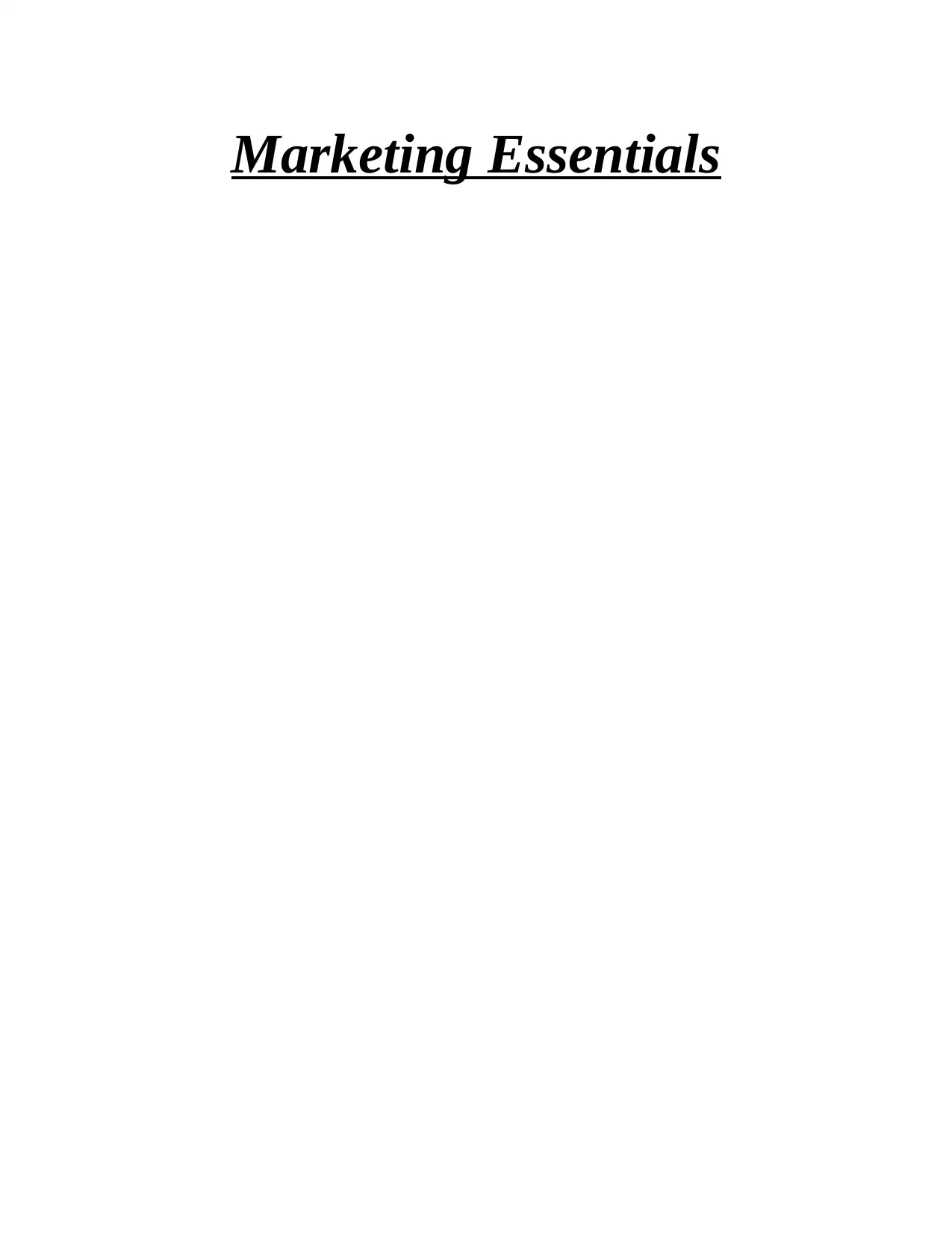
Marketing Essentials
Secure Best Marks with AI Grader
Need help grading? Try our AI Grader for instant feedback on your assignments.
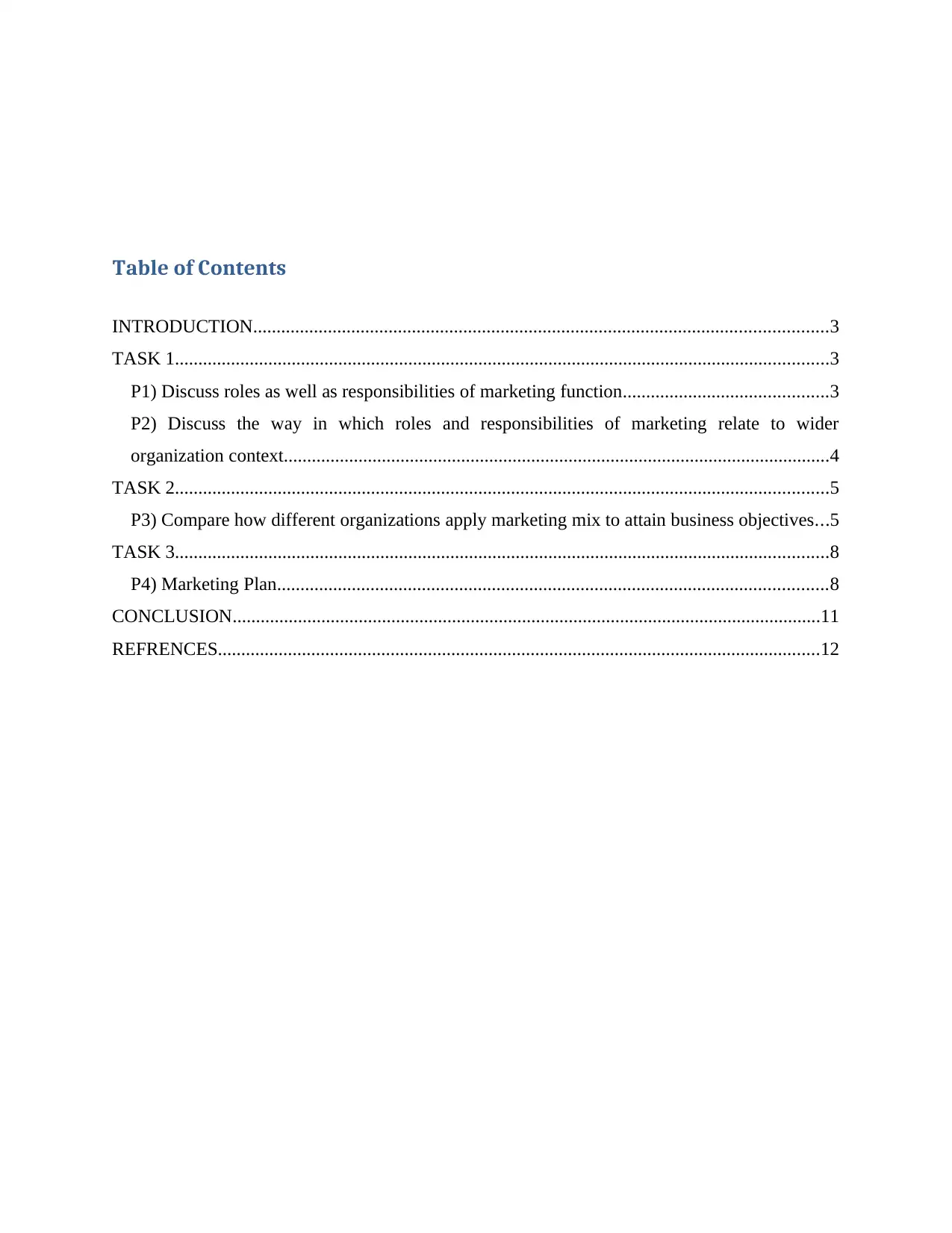
Table of Contents
INTRODUCTION...........................................................................................................................3
TASK 1............................................................................................................................................3
P1) Discuss roles as well as responsibilities of marketing function............................................3
P2) Discuss the way in which roles and responsibilities of marketing relate to wider
organization context.....................................................................................................................4
TASK 2............................................................................................................................................5
P3) Compare how different organizations apply marketing mix to attain business objectives...5
TASK 3............................................................................................................................................8
P4) Marketing Plan......................................................................................................................8
CONCLUSION..............................................................................................................................11
REFRENCES.................................................................................................................................12
INTRODUCTION...........................................................................................................................3
TASK 1............................................................................................................................................3
P1) Discuss roles as well as responsibilities of marketing function............................................3
P2) Discuss the way in which roles and responsibilities of marketing relate to wider
organization context.....................................................................................................................4
TASK 2............................................................................................................................................5
P3) Compare how different organizations apply marketing mix to attain business objectives...5
TASK 3............................................................................................................................................8
P4) Marketing Plan......................................................................................................................8
CONCLUSION..............................................................................................................................11
REFRENCES.................................................................................................................................12
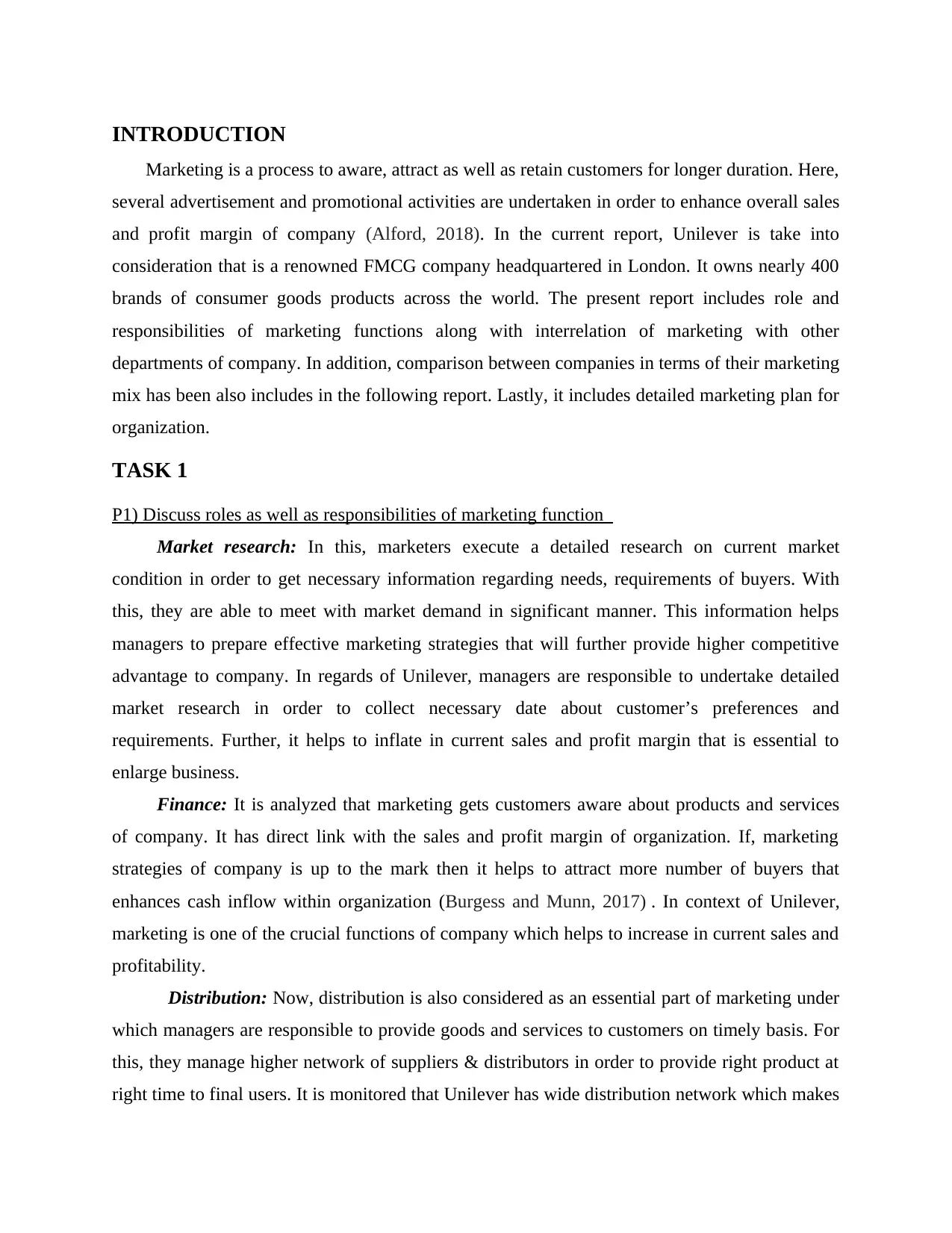
INTRODUCTION
Marketing is a process to aware, attract as well as retain customers for longer duration. Here,
several advertisement and promotional activities are undertaken in order to enhance overall sales
and profit margin of company (Alford, 2018). In the current report, Unilever is take into
consideration that is a renowned FMCG company headquartered in London. It owns nearly 400
brands of consumer goods products across the world. The present report includes role and
responsibilities of marketing functions along with interrelation of marketing with other
departments of company. In addition, comparison between companies in terms of their marketing
mix has been also includes in the following report. Lastly, it includes detailed marketing plan for
organization.
TASK 1
P1) Discuss roles as well as responsibilities of marketing function
Market research: In this, marketers execute a detailed research on current market
condition in order to get necessary information regarding needs, requirements of buyers. With
this, they are able to meet with market demand in significant manner. This information helps
managers to prepare effective marketing strategies that will further provide higher competitive
advantage to company. In regards of Unilever, managers are responsible to undertake detailed
market research in order to collect necessary date about customer’s preferences and
requirements. Further, it helps to inflate in current sales and profit margin that is essential to
enlarge business.
Finance: It is analyzed that marketing gets customers aware about products and services
of company. It has direct link with the sales and profit margin of organization. If, marketing
strategies of company is up to the mark then it helps to attract more number of buyers that
enhances cash inflow within organization (Burgess and Munn, 2017) . In context of Unilever,
marketing is one of the crucial functions of company which helps to increase in current sales and
profitability.
Distribution: Now, distribution is also considered as an essential part of marketing under
which managers are responsible to provide goods and services to customers on timely basis. For
this, they manage higher network of suppliers & distributors in order to provide right product at
right time to final users. It is monitored that Unilever has wide distribution network which makes
Marketing is a process to aware, attract as well as retain customers for longer duration. Here,
several advertisement and promotional activities are undertaken in order to enhance overall sales
and profit margin of company (Alford, 2018). In the current report, Unilever is take into
consideration that is a renowned FMCG company headquartered in London. It owns nearly 400
brands of consumer goods products across the world. The present report includes role and
responsibilities of marketing functions along with interrelation of marketing with other
departments of company. In addition, comparison between companies in terms of their marketing
mix has been also includes in the following report. Lastly, it includes detailed marketing plan for
organization.
TASK 1
P1) Discuss roles as well as responsibilities of marketing function
Market research: In this, marketers execute a detailed research on current market
condition in order to get necessary information regarding needs, requirements of buyers. With
this, they are able to meet with market demand in significant manner. This information helps
managers to prepare effective marketing strategies that will further provide higher competitive
advantage to company. In regards of Unilever, managers are responsible to undertake detailed
market research in order to collect necessary date about customer’s preferences and
requirements. Further, it helps to inflate in current sales and profit margin that is essential to
enlarge business.
Finance: It is analyzed that marketing gets customers aware about products and services
of company. It has direct link with the sales and profit margin of organization. If, marketing
strategies of company is up to the mark then it helps to attract more number of buyers that
enhances cash inflow within organization (Burgess and Munn, 2017) . In context of Unilever,
marketing is one of the crucial functions of company which helps to increase in current sales and
profitability.
Distribution: Now, distribution is also considered as an essential part of marketing under
which managers are responsible to provide goods and services to customers on timely basis. For
this, they manage higher network of suppliers & distributors in order to provide right product at
right time to final users. It is monitored that Unilever has wide distribution network which makes
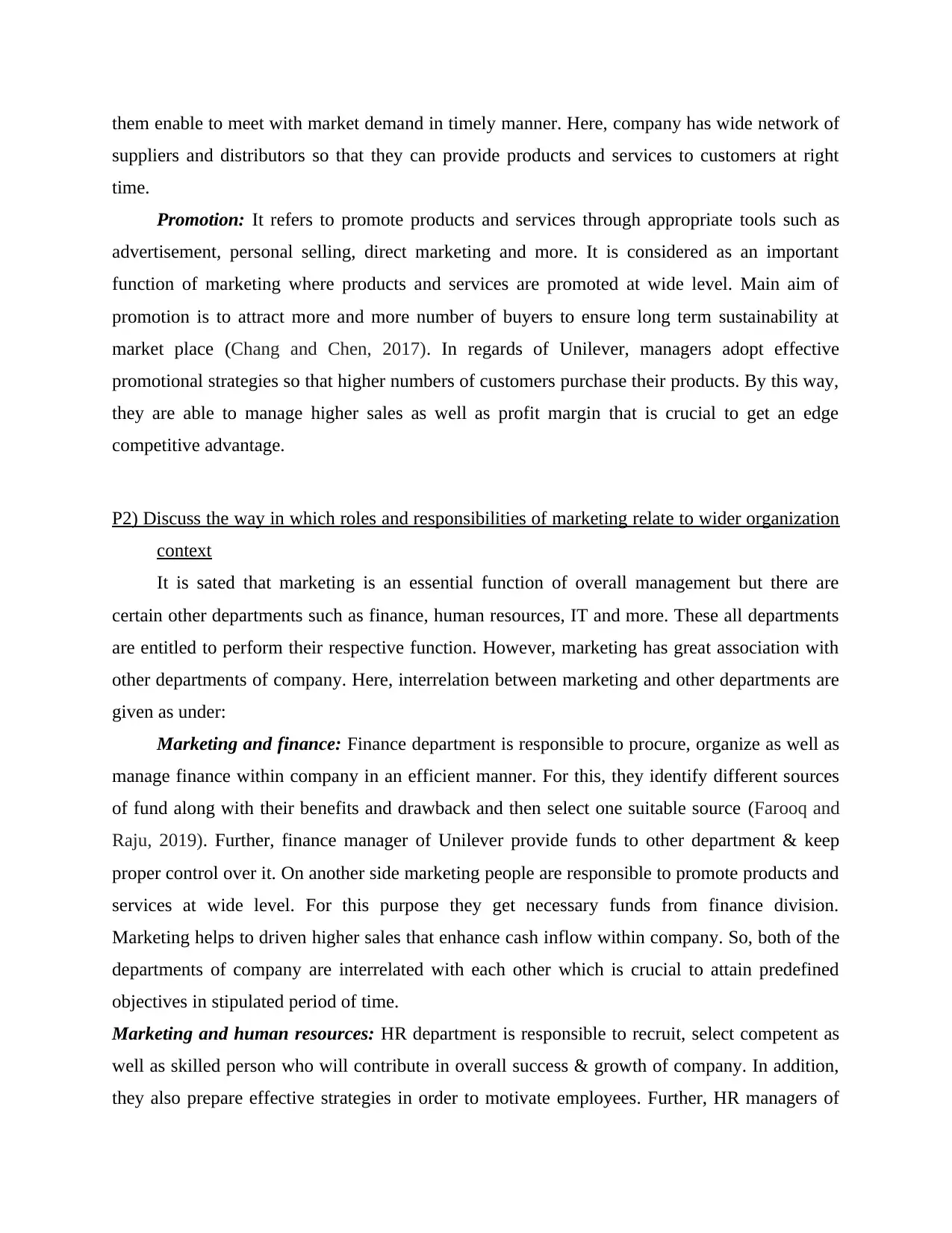
them enable to meet with market demand in timely manner. Here, company has wide network of
suppliers and distributors so that they can provide products and services to customers at right
time.
Promotion: It refers to promote products and services through appropriate tools such as
advertisement, personal selling, direct marketing and more. It is considered as an important
function of marketing where products and services are promoted at wide level. Main aim of
promotion is to attract more and more number of buyers to ensure long term sustainability at
market place (Chang and Chen, 2017). In regards of Unilever, managers adopt effective
promotional strategies so that higher numbers of customers purchase their products. By this way,
they are able to manage higher sales as well as profit margin that is crucial to get an edge
competitive advantage.
P2) Discuss the way in which roles and responsibilities of marketing relate to wider organization
context
It is sated that marketing is an essential function of overall management but there are
certain other departments such as finance, human resources, IT and more. These all departments
are entitled to perform their respective function. However, marketing has great association with
other departments of company. Here, interrelation between marketing and other departments are
given as under:
Marketing and finance: Finance department is responsible to procure, organize as well as
manage finance within company in an efficient manner. For this, they identify different sources
of fund along with their benefits and drawback and then select one suitable source (Farooq and
Raju, 2019). Further, finance manager of Unilever provide funds to other department & keep
proper control over it. On another side marketing people are responsible to promote products and
services at wide level. For this purpose they get necessary funds from finance division.
Marketing helps to driven higher sales that enhance cash inflow within company. So, both of the
departments of company are interrelated with each other which is crucial to attain predefined
objectives in stipulated period of time.
Marketing and human resources: HR department is responsible to recruit, select competent as
well as skilled person who will contribute in overall success & growth of company. In addition,
they also prepare effective strategies in order to motivate employees. Further, HR managers of
suppliers and distributors so that they can provide products and services to customers at right
time.
Promotion: It refers to promote products and services through appropriate tools such as
advertisement, personal selling, direct marketing and more. It is considered as an important
function of marketing where products and services are promoted at wide level. Main aim of
promotion is to attract more and more number of buyers to ensure long term sustainability at
market place (Chang and Chen, 2017). In regards of Unilever, managers adopt effective
promotional strategies so that higher numbers of customers purchase their products. By this way,
they are able to manage higher sales as well as profit margin that is crucial to get an edge
competitive advantage.
P2) Discuss the way in which roles and responsibilities of marketing relate to wider organization
context
It is sated that marketing is an essential function of overall management but there are
certain other departments such as finance, human resources, IT and more. These all departments
are entitled to perform their respective function. However, marketing has great association with
other departments of company. Here, interrelation between marketing and other departments are
given as under:
Marketing and finance: Finance department is responsible to procure, organize as well as
manage finance within company in an efficient manner. For this, they identify different sources
of fund along with their benefits and drawback and then select one suitable source (Farooq and
Raju, 2019). Further, finance manager of Unilever provide funds to other department & keep
proper control over it. On another side marketing people are responsible to promote products and
services at wide level. For this purpose they get necessary funds from finance division.
Marketing helps to driven higher sales that enhance cash inflow within company. So, both of the
departments of company are interrelated with each other which is crucial to attain predefined
objectives in stipulated period of time.
Marketing and human resources: HR department is responsible to recruit, select competent as
well as skilled person who will contribute in overall success & growth of company. In addition,
they also prepare effective strategies in order to motivate employees. Further, HR managers of
Secure Best Marks with AI Grader
Need help grading? Try our AI Grader for instant feedback on your assignments.
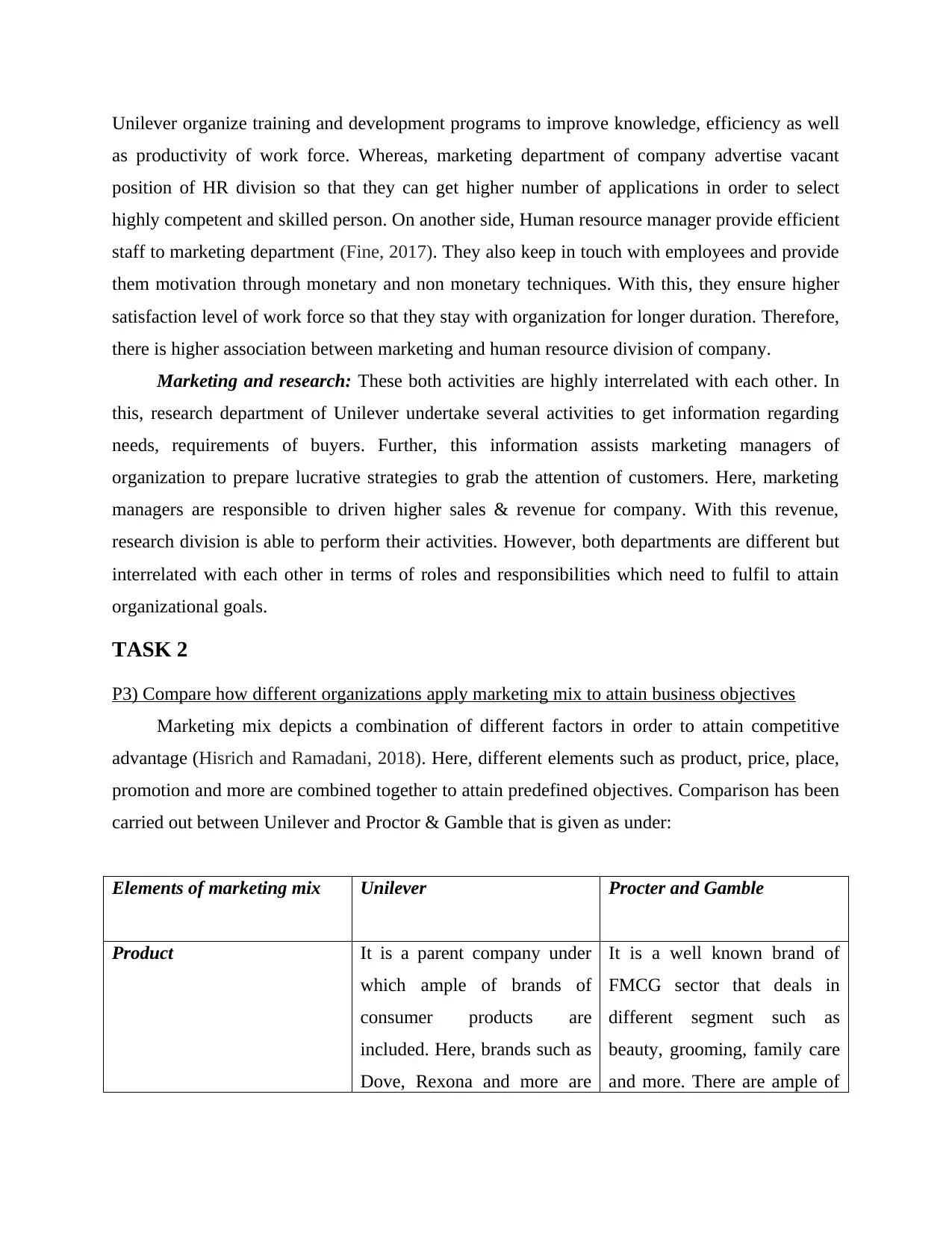
Unilever organize training and development programs to improve knowledge, efficiency as well
as productivity of work force. Whereas, marketing department of company advertise vacant
position of HR division so that they can get higher number of applications in order to select
highly competent and skilled person. On another side, Human resource manager provide efficient
staff to marketing department (Fine, 2017). They also keep in touch with employees and provide
them motivation through monetary and non monetary techniques. With this, they ensure higher
satisfaction level of work force so that they stay with organization for longer duration. Therefore,
there is higher association between marketing and human resource division of company.
Marketing and research: These both activities are highly interrelated with each other. In
this, research department of Unilever undertake several activities to get information regarding
needs, requirements of buyers. Further, this information assists marketing managers of
organization to prepare lucrative strategies to grab the attention of customers. Here, marketing
managers are responsible to driven higher sales & revenue for company. With this revenue,
research division is able to perform their activities. However, both departments are different but
interrelated with each other in terms of roles and responsibilities which need to fulfil to attain
organizational goals.
TASK 2
P3) Compare how different organizations apply marketing mix to attain business objectives
Marketing mix depicts a combination of different factors in order to attain competitive
advantage (Hisrich and Ramadani, 2018). Here, different elements such as product, price, place,
promotion and more are combined together to attain predefined objectives. Comparison has been
carried out between Unilever and Proctor & Gamble that is given as under:
Elements of marketing mix Unilever Procter and Gamble
Product It is a parent company under
which ample of brands of
consumer products are
included. Here, brands such as
Dove, Rexona and more are
It is a well known brand of
FMCG sector that deals in
different segment such as
beauty, grooming, family care
and more. There are ample of
as productivity of work force. Whereas, marketing department of company advertise vacant
position of HR division so that they can get higher number of applications in order to select
highly competent and skilled person. On another side, Human resource manager provide efficient
staff to marketing department (Fine, 2017). They also keep in touch with employees and provide
them motivation through monetary and non monetary techniques. With this, they ensure higher
satisfaction level of work force so that they stay with organization for longer duration. Therefore,
there is higher association between marketing and human resource division of company.
Marketing and research: These both activities are highly interrelated with each other. In
this, research department of Unilever undertake several activities to get information regarding
needs, requirements of buyers. Further, this information assists marketing managers of
organization to prepare lucrative strategies to grab the attention of customers. Here, marketing
managers are responsible to driven higher sales & revenue for company. With this revenue,
research division is able to perform their activities. However, both departments are different but
interrelated with each other in terms of roles and responsibilities which need to fulfil to attain
organizational goals.
TASK 2
P3) Compare how different organizations apply marketing mix to attain business objectives
Marketing mix depicts a combination of different factors in order to attain competitive
advantage (Hisrich and Ramadani, 2018). Here, different elements such as product, price, place,
promotion and more are combined together to attain predefined objectives. Comparison has been
carried out between Unilever and Proctor & Gamble that is given as under:
Elements of marketing mix Unilever Procter and Gamble
Product It is a parent company under
which ample of brands of
consumer products are
included. Here, brands such as
Dove, Rexona and more are
It is a well known brand of
FMCG sector that deals in
different segment such as
beauty, grooming, family care
and more. There are ample of
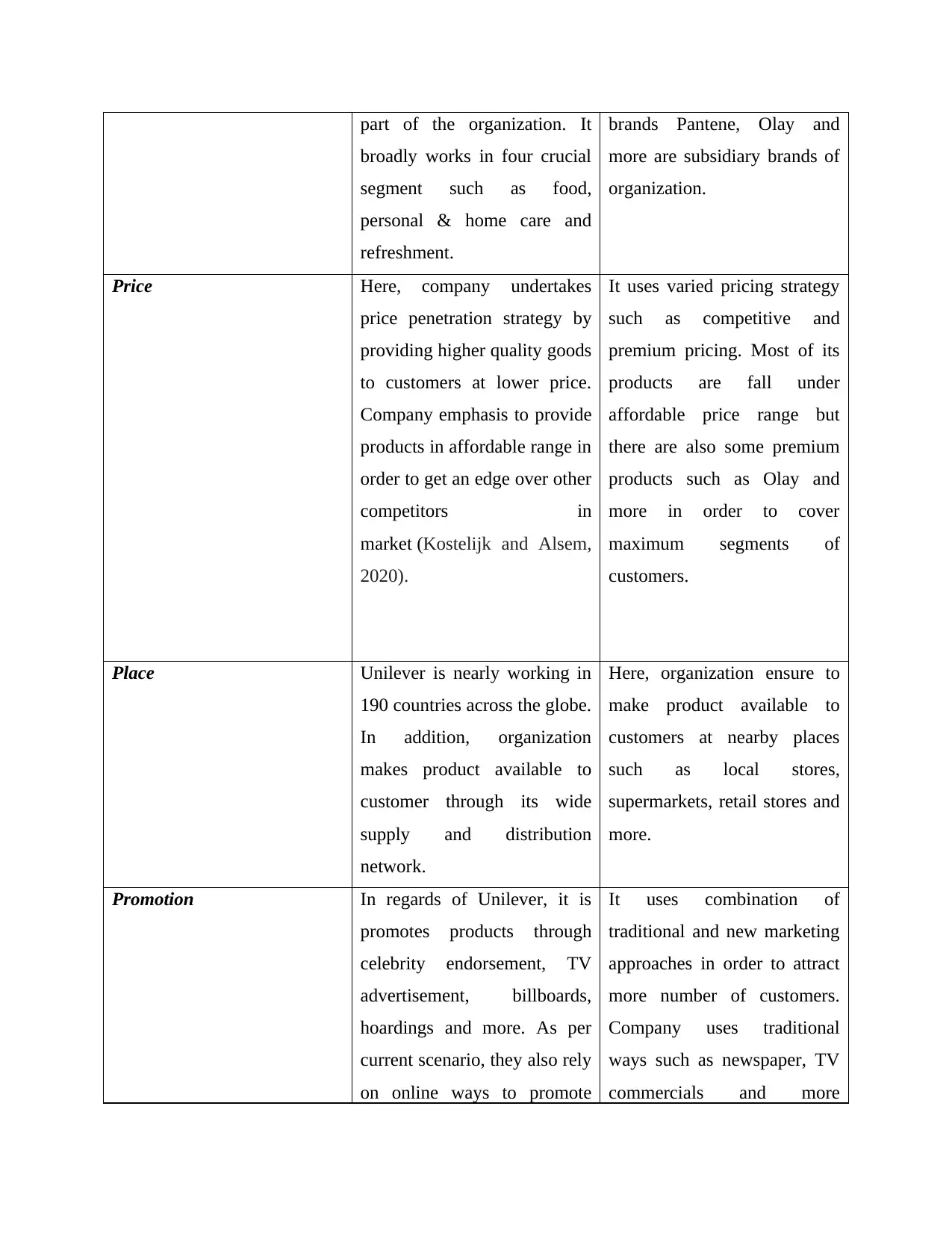
part of the organization. It
broadly works in four crucial
segment such as food,
personal & home care and
refreshment.
brands Pantene, Olay and
more are subsidiary brands of
organization.
Price Here, company undertakes
price penetration strategy by
providing higher quality goods
to customers at lower price.
Company emphasis to provide
products in affordable range in
order to get an edge over other
competitors in
market (Kostelijk and Alsem,
2020).
It uses varied pricing strategy
such as competitive and
premium pricing. Most of its
products are fall under
affordable price range but
there are also some premium
products such as Olay and
more in order to cover
maximum segments of
customers.
Place Unilever is nearly working in
190 countries across the globe.
In addition, organization
makes product available to
customer through its wide
supply and distribution
network.
Here, organization ensure to
make product available to
customers at nearby places
such as local stores,
supermarkets, retail stores and
more.
Promotion In regards of Unilever, it is
promotes products through
celebrity endorsement, TV
advertisement, billboards,
hoardings and more. As per
current scenario, they also rely
on online ways to promote
It uses combination of
traditional and new marketing
approaches in order to attract
more number of customers.
Company uses traditional
ways such as newspaper, TV
commercials and more
broadly works in four crucial
segment such as food,
personal & home care and
refreshment.
brands Pantene, Olay and
more are subsidiary brands of
organization.
Price Here, company undertakes
price penetration strategy by
providing higher quality goods
to customers at lower price.
Company emphasis to provide
products in affordable range in
order to get an edge over other
competitors in
market (Kostelijk and Alsem,
2020).
It uses varied pricing strategy
such as competitive and
premium pricing. Most of its
products are fall under
affordable price range but
there are also some premium
products such as Olay and
more in order to cover
maximum segments of
customers.
Place Unilever is nearly working in
190 countries across the globe.
In addition, organization
makes product available to
customer through its wide
supply and distribution
network.
Here, organization ensure to
make product available to
customers at nearby places
such as local stores,
supermarkets, retail stores and
more.
Promotion In regards of Unilever, it is
promotes products through
celebrity endorsement, TV
advertisement, billboards,
hoardings and more. As per
current scenario, they also rely
on online ways to promote
It uses combination of
traditional and new marketing
approaches in order to attract
more number of customers.
Company uses traditional
ways such as newspaper, TV
commercials and more
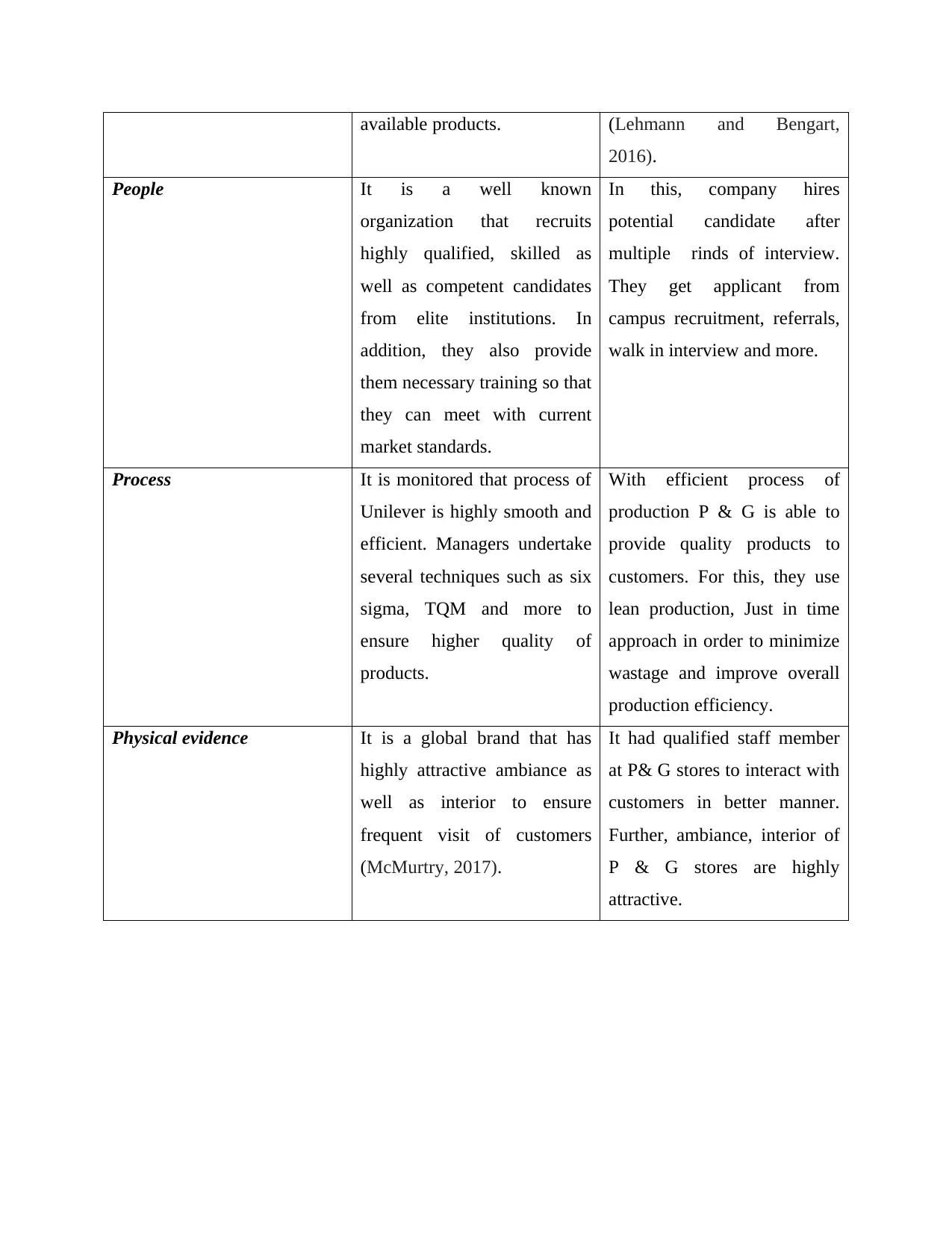
available products. (Lehmann and Bengart,
2016).
People It is a well known
organization that recruits
highly qualified, skilled as
well as competent candidates
from elite institutions. In
addition, they also provide
them necessary training so that
they can meet with current
market standards.
In this, company hires
potential candidate after
multiple rinds of interview.
They get applicant from
campus recruitment, referrals,
walk in interview and more.
Process It is monitored that process of
Unilever is highly smooth and
efficient. Managers undertake
several techniques such as six
sigma, TQM and more to
ensure higher quality of
products.
With efficient process of
production P & G is able to
provide quality products to
customers. For this, they use
lean production, Just in time
approach in order to minimize
wastage and improve overall
production efficiency.
Physical evidence It is a global brand that has
highly attractive ambiance as
well as interior to ensure
frequent visit of customers
(McMurtry, 2017).
It had qualified staff member
at P& G stores to interact with
customers in better manner.
Further, ambiance, interior of
P & G stores are highly
attractive.
2016).
People It is a well known
organization that recruits
highly qualified, skilled as
well as competent candidates
from elite institutions. In
addition, they also provide
them necessary training so that
they can meet with current
market standards.
In this, company hires
potential candidate after
multiple rinds of interview.
They get applicant from
campus recruitment, referrals,
walk in interview and more.
Process It is monitored that process of
Unilever is highly smooth and
efficient. Managers undertake
several techniques such as six
sigma, TQM and more to
ensure higher quality of
products.
With efficient process of
production P & G is able to
provide quality products to
customers. For this, they use
lean production, Just in time
approach in order to minimize
wastage and improve overall
production efficiency.
Physical evidence It is a global brand that has
highly attractive ambiance as
well as interior to ensure
frequent visit of customers
(McMurtry, 2017).
It had qualified staff member
at P& G stores to interact with
customers in better manner.
Further, ambiance, interior of
P & G stores are highly
attractive.
Paraphrase This Document
Need a fresh take? Get an instant paraphrase of this document with our AI Paraphraser
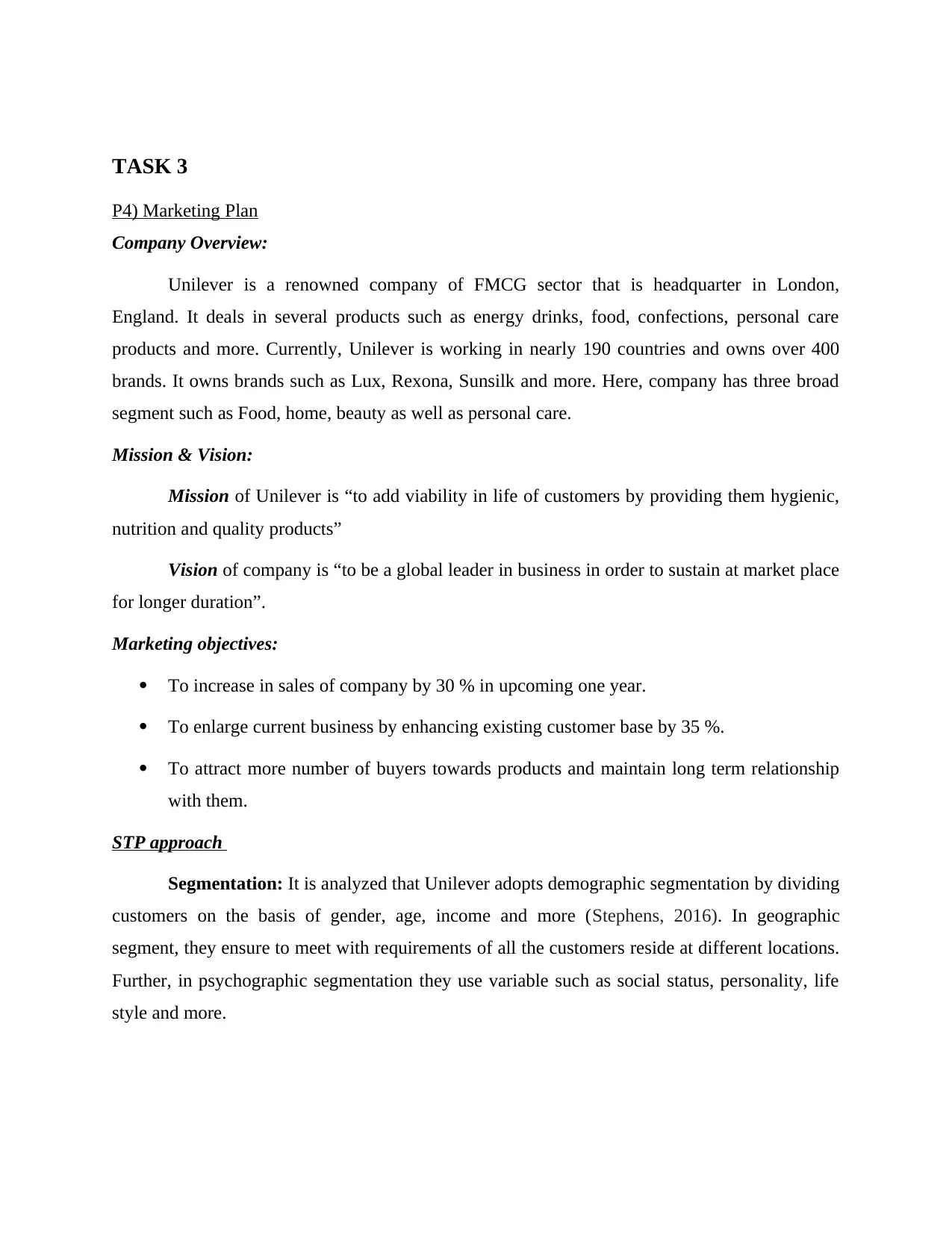
TASK 3
P4) Marketing Plan
Company Overview:
Unilever is a renowned company of FMCG sector that is headquarter in London,
England. It deals in several products such as energy drinks, food, confections, personal care
products and more. Currently, Unilever is working in nearly 190 countries and owns over 400
brands. It owns brands such as Lux, Rexona, Sunsilk and more. Here, company has three broad
segment such as Food, home, beauty as well as personal care.
Mission & Vision:
Mission of Unilever is “to add viability in life of customers by providing them hygienic,
nutrition and quality products”
Vision of company is “to be a global leader in business in order to sustain at market place
for longer duration”.
Marketing objectives:
To increase in sales of company by 30 % in upcoming one year.
To enlarge current business by enhancing existing customer base by 35 %.
To attract more number of buyers towards products and maintain long term relationship
with them.
STP approach
Segmentation: It is analyzed that Unilever adopts demographic segmentation by dividing
customers on the basis of gender, age, income and more (Stephens, 2016). In geographic
segment, they ensure to meet with requirements of all the customers reside at different locations.
Further, in psychographic segmentation they use variable such as social status, personality, life
style and more.
P4) Marketing Plan
Company Overview:
Unilever is a renowned company of FMCG sector that is headquarter in London,
England. It deals in several products such as energy drinks, food, confections, personal care
products and more. Currently, Unilever is working in nearly 190 countries and owns over 400
brands. It owns brands such as Lux, Rexona, Sunsilk and more. Here, company has three broad
segment such as Food, home, beauty as well as personal care.
Mission & Vision:
Mission of Unilever is “to add viability in life of customers by providing them hygienic,
nutrition and quality products”
Vision of company is “to be a global leader in business in order to sustain at market place
for longer duration”.
Marketing objectives:
To increase in sales of company by 30 % in upcoming one year.
To enlarge current business by enhancing existing customer base by 35 %.
To attract more number of buyers towards products and maintain long term relationship
with them.
STP approach
Segmentation: It is analyzed that Unilever adopts demographic segmentation by dividing
customers on the basis of gender, age, income and more (Stephens, 2016). In geographic
segment, they ensure to meet with requirements of all the customers reside at different locations.
Further, in psychographic segmentation they use variable such as social status, personality, life
style and more.
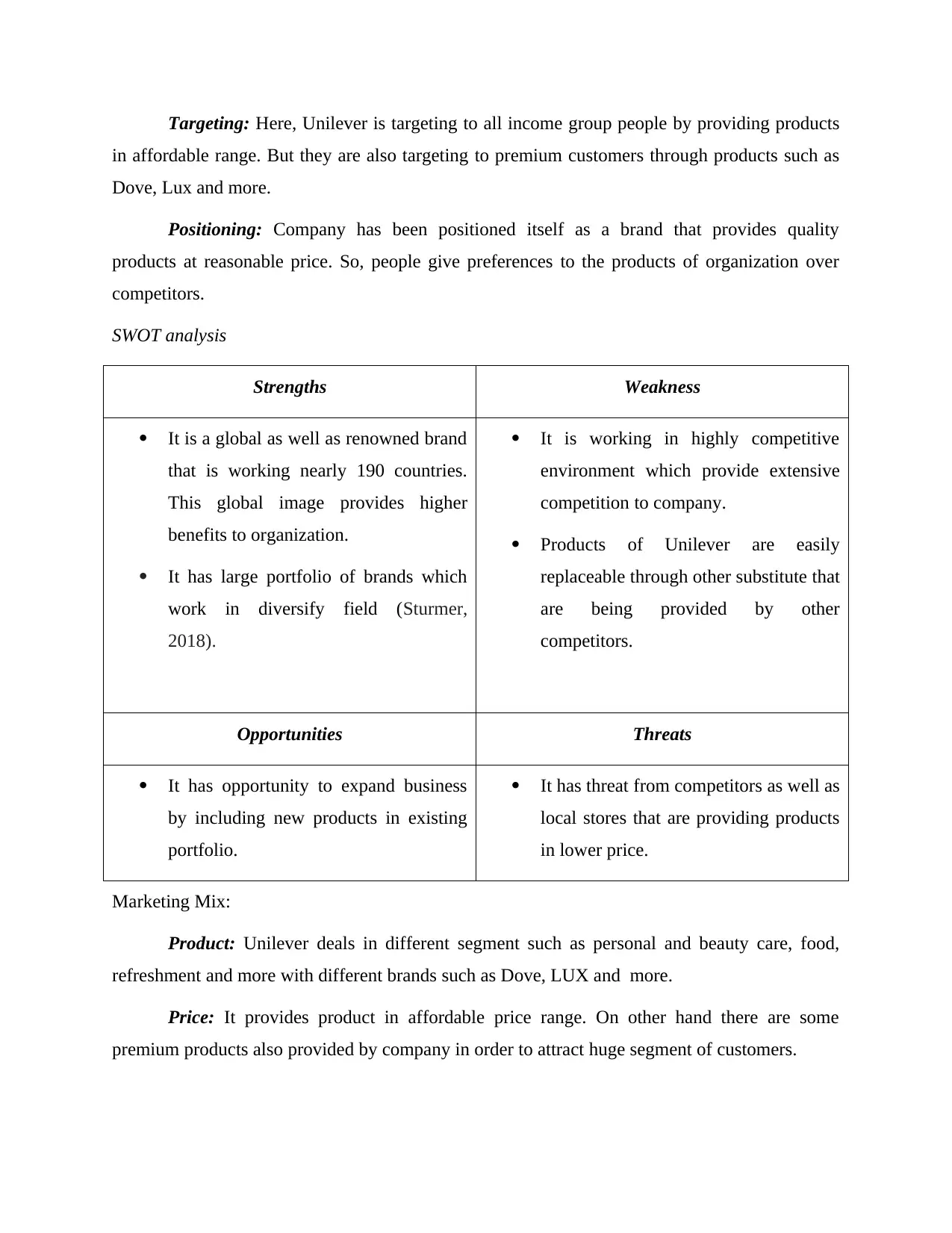
Targeting: Here, Unilever is targeting to all income group people by providing products
in affordable range. But they are also targeting to premium customers through products such as
Dove, Lux and more.
Positioning: Company has been positioned itself as a brand that provides quality
products at reasonable price. So, people give preferences to the products of organization over
competitors.
SWOT analysis
Strengths Weakness
It is a global as well as renowned brand
that is working nearly 190 countries.
This global image provides higher
benefits to organization.
It has large portfolio of brands which
work in diversify field (Sturmer,
2018).
It is working in highly competitive
environment which provide extensive
competition to company.
Products of Unilever are easily
replaceable through other substitute that
are being provided by other
competitors.
Opportunities Threats
It has opportunity to expand business
by including new products in existing
portfolio.
It has threat from competitors as well as
local stores that are providing products
in lower price.
Marketing Mix:
Product: Unilever deals in different segment such as personal and beauty care, food,
refreshment and more with different brands such as Dove, LUX and more.
Price: It provides product in affordable price range. On other hand there are some
premium products also provided by company in order to attract huge segment of customers.
in affordable range. But they are also targeting to premium customers through products such as
Dove, Lux and more.
Positioning: Company has been positioned itself as a brand that provides quality
products at reasonable price. So, people give preferences to the products of organization over
competitors.
SWOT analysis
Strengths Weakness
It is a global as well as renowned brand
that is working nearly 190 countries.
This global image provides higher
benefits to organization.
It has large portfolio of brands which
work in diversify field (Sturmer,
2018).
It is working in highly competitive
environment which provide extensive
competition to company.
Products of Unilever are easily
replaceable through other substitute that
are being provided by other
competitors.
Opportunities Threats
It has opportunity to expand business
by including new products in existing
portfolio.
It has threat from competitors as well as
local stores that are providing products
in lower price.
Marketing Mix:
Product: Unilever deals in different segment such as personal and beauty care, food,
refreshment and more with different brands such as Dove, LUX and more.
Price: It provides product in affordable price range. On other hand there are some
premium products also provided by company in order to attract huge segment of customers.
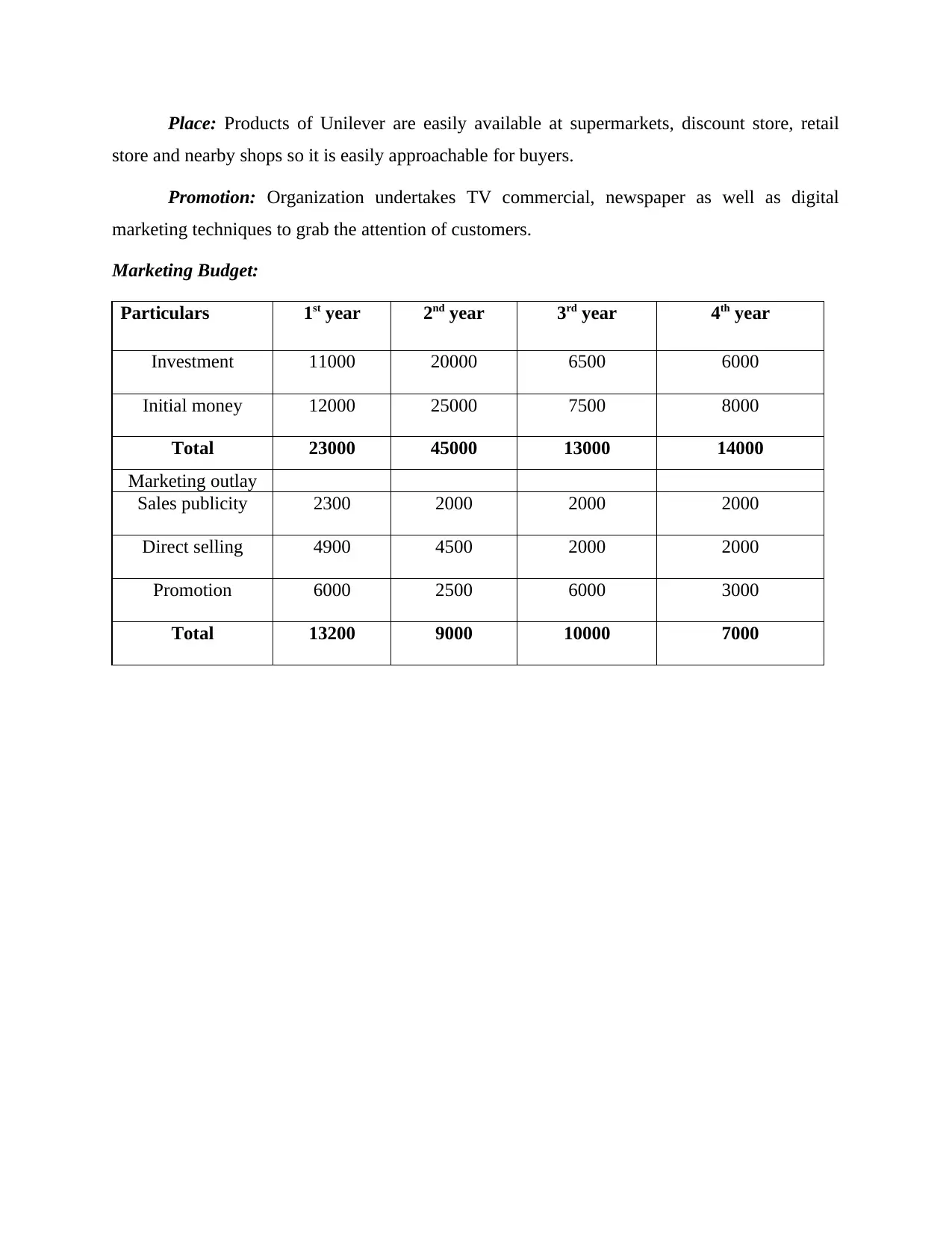
Place: Products of Unilever are easily available at supermarkets, discount store, retail
store and nearby shops so it is easily approachable for buyers.
Promotion: Organization undertakes TV commercial, newspaper as well as digital
marketing techniques to grab the attention of customers.
Marketing Budget:
Particulars 1st year 2nd year 3rd year 4th year
Investment 11000 20000 6500 6000
Initial money 12000 25000 7500 8000
Total 23000 45000 13000 14000
Marketing outlay
Sales publicity 2300 2000 2000 2000
Direct selling 4900 4500 2000 2000
Promotion 6000 2500 6000 3000
Total 13200 9000 10000 7000
store and nearby shops so it is easily approachable for buyers.
Promotion: Organization undertakes TV commercial, newspaper as well as digital
marketing techniques to grab the attention of customers.
Marketing Budget:
Particulars 1st year 2nd year 3rd year 4th year
Investment 11000 20000 6500 6000
Initial money 12000 25000 7500 8000
Total 23000 45000 13000 14000
Marketing outlay
Sales publicity 2300 2000 2000 2000
Direct selling 4900 4500 2000 2000
Promotion 6000 2500 6000 3000
Total 13200 9000 10000 7000
Secure Best Marks with AI Grader
Need help grading? Try our AI Grader for instant feedback on your assignments.
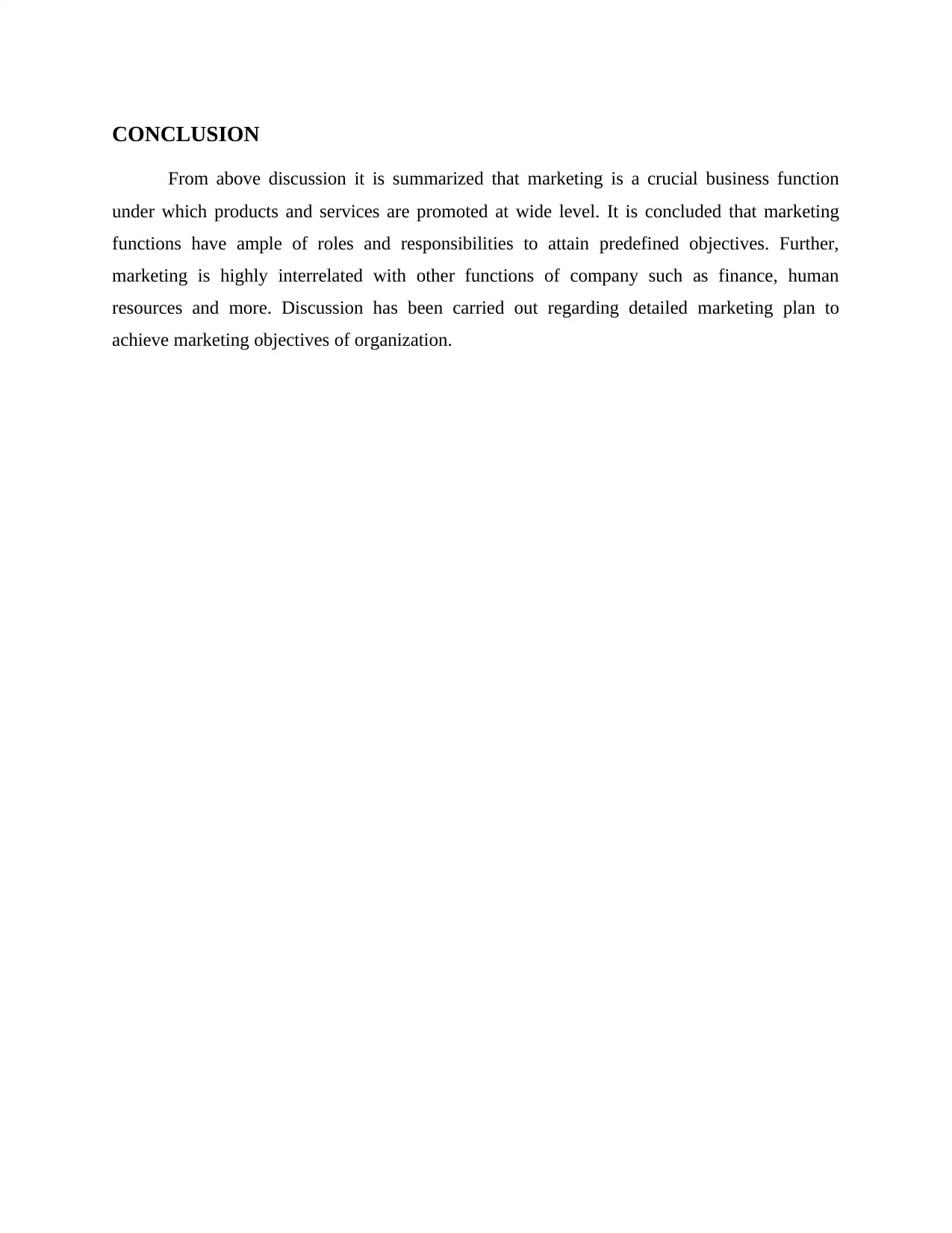
CONCLUSION
From above discussion it is summarized that marketing is a crucial business function
under which products and services are promoted at wide level. It is concluded that marketing
functions have ample of roles and responsibilities to attain predefined objectives. Further,
marketing is highly interrelated with other functions of company such as finance, human
resources and more. Discussion has been carried out regarding detailed marketing plan to
achieve marketing objectives of organization.
From above discussion it is summarized that marketing is a crucial business function
under which products and services are promoted at wide level. It is concluded that marketing
functions have ample of roles and responsibilities to attain predefined objectives. Further,
marketing is highly interrelated with other functions of company such as finance, human
resources and more. Discussion has been carried out regarding detailed marketing plan to
achieve marketing objectives of organization.
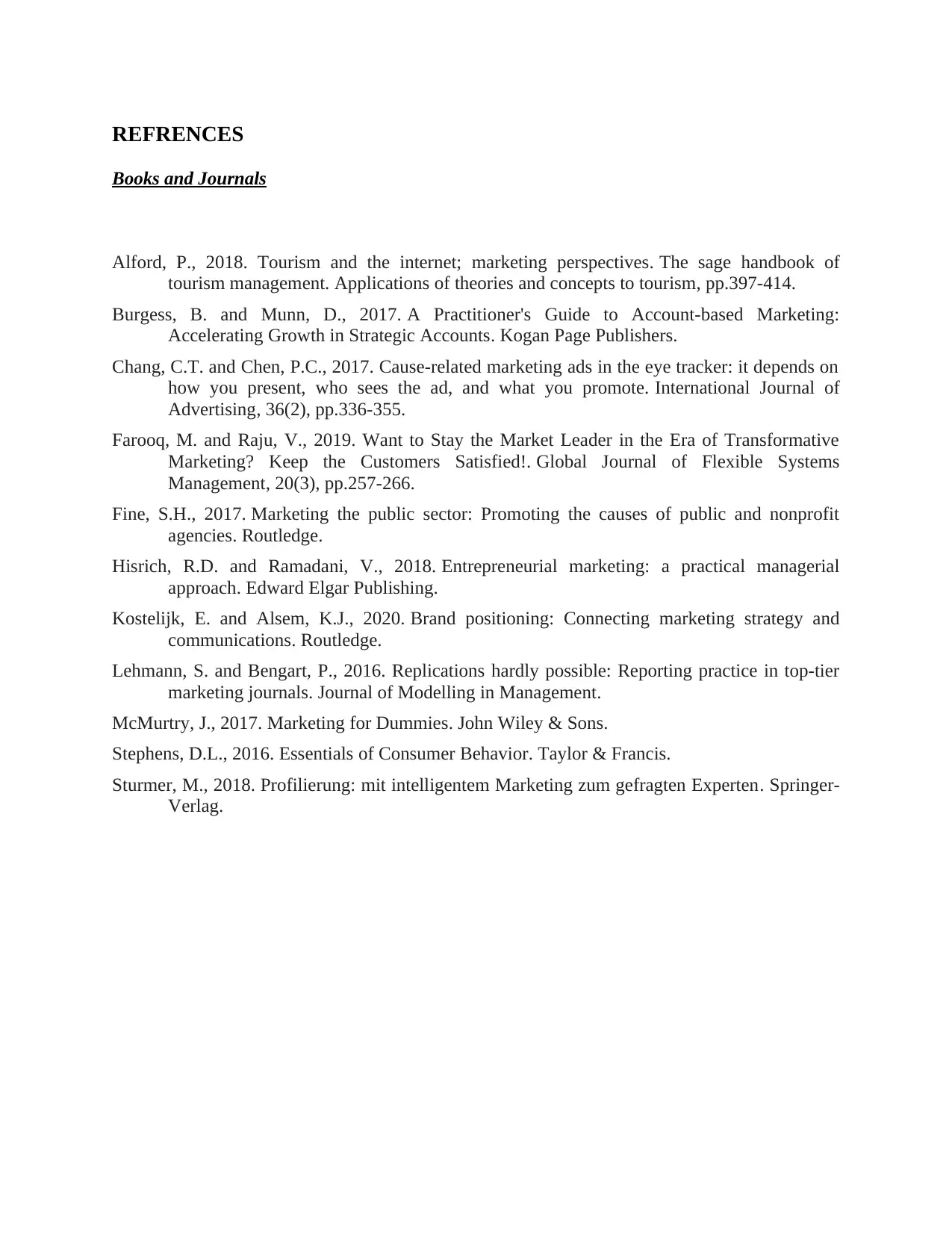
REFRENCES
Books and Journals
Alford, P., 2018. Tourism and the internet; marketing perspectives. The sage handbook of
tourism management. Applications of theories and concepts to tourism, pp.397-414.
Burgess, B. and Munn, D., 2017. A Practitioner's Guide to Account-based Marketing:
Accelerating Growth in Strategic Accounts. Kogan Page Publishers.
Chang, C.T. and Chen, P.C., 2017. Cause-related marketing ads in the eye tracker: it depends on
how you present, who sees the ad, and what you promote. International Journal of
Advertising, 36(2), pp.336-355.
Farooq, M. and Raju, V., 2019. Want to Stay the Market Leader in the Era of Transformative
Marketing? Keep the Customers Satisfied!. Global Journal of Flexible Systems
Management, 20(3), pp.257-266.
Fine, S.H., 2017. Marketing the public sector: Promoting the causes of public and nonprofit
agencies. Routledge.
Hisrich, R.D. and Ramadani, V., 2018. Entrepreneurial marketing: a practical managerial
approach. Edward Elgar Publishing.
Kostelijk, E. and Alsem, K.J., 2020. Brand positioning: Connecting marketing strategy and
communications. Routledge.
Lehmann, S. and Bengart, P., 2016. Replications hardly possible: Reporting practice in top-tier
marketing journals. Journal of Modelling in Management.
McMurtry, J., 2017. Marketing for Dummies. John Wiley & Sons.
Stephens, D.L., 2016. Essentials of Consumer Behavior. Taylor & Francis.
Sturmer, M., 2018. Profilierung: mit intelligentem Marketing zum gefragten Experten. Springer-
Verlag.
Books and Journals
Alford, P., 2018. Tourism and the internet; marketing perspectives. The sage handbook of
tourism management. Applications of theories and concepts to tourism, pp.397-414.
Burgess, B. and Munn, D., 2017. A Practitioner's Guide to Account-based Marketing:
Accelerating Growth in Strategic Accounts. Kogan Page Publishers.
Chang, C.T. and Chen, P.C., 2017. Cause-related marketing ads in the eye tracker: it depends on
how you present, who sees the ad, and what you promote. International Journal of
Advertising, 36(2), pp.336-355.
Farooq, M. and Raju, V., 2019. Want to Stay the Market Leader in the Era of Transformative
Marketing? Keep the Customers Satisfied!. Global Journal of Flexible Systems
Management, 20(3), pp.257-266.
Fine, S.H., 2017. Marketing the public sector: Promoting the causes of public and nonprofit
agencies. Routledge.
Hisrich, R.D. and Ramadani, V., 2018. Entrepreneurial marketing: a practical managerial
approach. Edward Elgar Publishing.
Kostelijk, E. and Alsem, K.J., 2020. Brand positioning: Connecting marketing strategy and
communications. Routledge.
Lehmann, S. and Bengart, P., 2016. Replications hardly possible: Reporting practice in top-tier
marketing journals. Journal of Modelling in Management.
McMurtry, J., 2017. Marketing for Dummies. John Wiley & Sons.
Stephens, D.L., 2016. Essentials of Consumer Behavior. Taylor & Francis.
Sturmer, M., 2018. Profilierung: mit intelligentem Marketing zum gefragten Experten. Springer-
Verlag.
1 out of 12
Related Documents
Your All-in-One AI-Powered Toolkit for Academic Success.
+13062052269
info@desklib.com
Available 24*7 on WhatsApp / Email
![[object Object]](/_next/static/media/star-bottom.7253800d.svg)
Unlock your academic potential
© 2024 | Zucol Services PVT LTD | All rights reserved.





